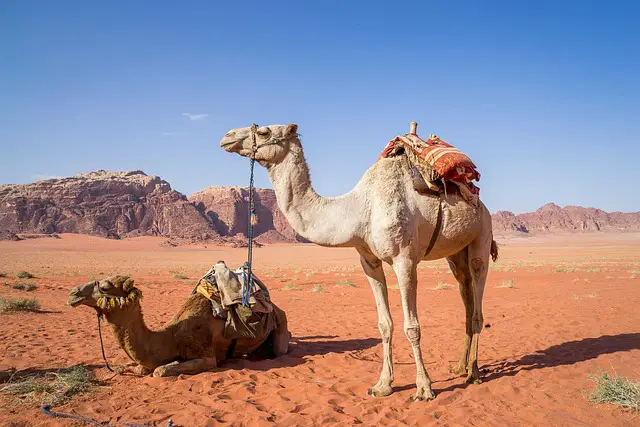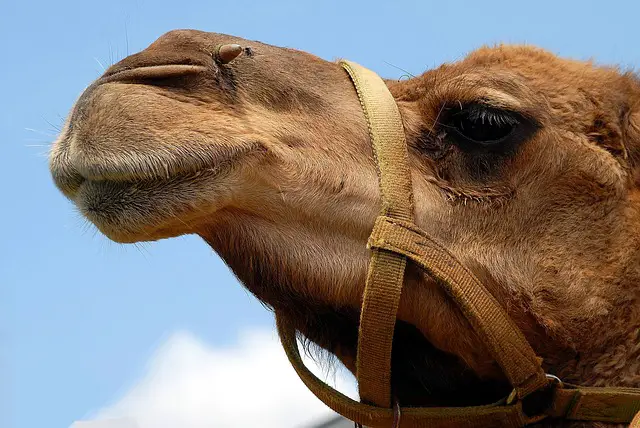Here are the most significant camel facts for kids including camels diet, habitat, domestication and several other purposes. A camel is a flat-toed ungulate belong to the genus Camelus. It has couple of humps at its back. Two camel species have been discovered; one is endemic to the Middle East and Africa while the other one lives in the Central Asia. Camels have long been recognized as domesticated animals as they are widely employed for several purposes by humans. Camel is the great source of milk, hair, meat, and for traveling vast distances especially in deserts. They can easily run on deserts which is why they are called the “Ship of the Desert”. Now let’s check out some of the most interesting facts about camels including its physical appearance, diet, and habitat.
Amazing Camel Facts For Kids
- On an average, camel can survive up to 40 to 5o years
- The shoulder height of camel measures around (6 feet 1 inch), while the height from the camels humps is 2.15 meters (7 feet 1 inch).
- The length of the hump from its body is 75 cm (30 inches).
- Camels are capable to run at a speed of about 65 km/h (40 mph) but in short bursts however they can retain the average speed of 40 km/h (25 mph).
- There is a strange organ in the male camel’s mouth which is extruded from its mouth in order to draw female’s attention. This organ is called dulla.
- Contrary to a common belief, camels do not store water in their humps. These humps are basically the reservoir of fatty tissues. These fatty tanks reduce the heat-trapping insulation across the camel’s body, thereby allowing these animals to survive under intense heat.
- Thanks to the physiological adaptations of a camel, it can hold out without water for long periods of time.
- Unlike other mammals, camels have oval-shaped red blood cells as against the circular in other mammals. This ensures the blood flow even in a dehydrated condition.
- Camels are known to drink large amount of water with an estimate of 100 litres (26 US gallons) in one time.
- The camel’s temperature ranges from 41o C (106o C) during daytime, while at night the temperature is 34o C (93o F).
- Camels can swim.
- The camel’s ancestors are known to have been evolved from North America during the period of Palaeogene, and later they spread out in different parts of the Asia.
- Protylopus is the earliest known camel that lived in North America some 40 to 50 million years ago.
- These animals were first domesticated by the ancient Somalia before 2000 BC.
- The majority of the camels are used for either domestication or ferel.
- One of the amazing facts about camels for kids is that they can resist 20 – 25% weight loss because of sweating in comparison to other mammals (15%).
 What Do Camels Eat
What Do Camels Eat
Camels are herbivorous and they primarily eat green herbage to preserve their hydrated condition of their body without requiring water. These animals are strong and they munch on thorny desert plants. With the help of their long eyelashes and ear hairs, it provides an absolute protection from the desert sands. The camel’s feet do not sink into the sand due to its widened feet and gait.
Camels are naturally equipped with a leathery mouth that allow them to feed on thorny plants of almost any kind. Read on more about Camels diet at What do camels eat
 Where Do Camels Live | Facts about Camels for Kids
Where Do Camels Live | Facts about Camels for Kids
Camels reside in several parts of the world including Horn of Africa, Middle East, Sahel, Maghreb, South Asia, with the greatest population live in Horn region. The Bactrian camels population faced sudden decline with only 1.4 million animals left that serves for domesticated purposes. There are around 1,000 Bactrian camels in Gobi Desert, China. In central parts of Australia, the estimated population of these mammals is about 1,000,000. The population is increasing at 8% each year.
Camel Facts For Kids | Video


Leave a Reply